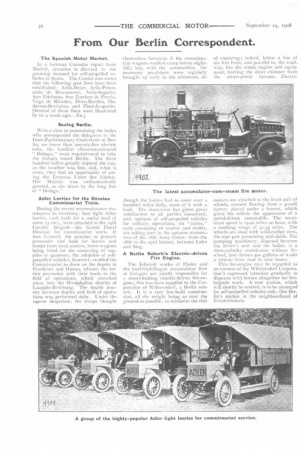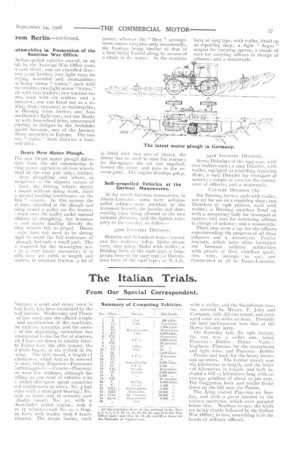From Our Berlin Correspondent.
Page 16

Page 17

If you've noticed an error in this article please click here to report it so we can fix it.
The Spanish Motor Market.
In a German Consular report from Madrid, attention is directed to the growing demand for self-propelled vehicles in Spain. The Consul also states that the following post lines have been established : Avila-Bejar, Avila-Penaranda de Bracamonte, Avila-SegoviaSan Ildefonso, San Esteban de PraviaVega de Rivadeo, Deva-Mortico, Ondarroa-Berriatua, and Plaza-Lequetio. [Several of these lines were illustrated by us a week ago.—E.D.1 Seeing Berlin.
With a view to entertaining the ladies who accompanied the delegates to the Inter-Parliamentary Conference at I;erlin, no fewer than seventy-five electric cabs, the familiar chocolate-coloured " Bedags," were requisitioned to take the visitors round Berlin. The three hundred ladies greatly enjoyed the run, as the weather was fine, and, what is more, they had an opportunity of seeing the Empress tinter den Linden. I ler Majesty was enthusiastically greeted, as she drove by the long line of " Bedags,"
Adler Lorries for the Hessian Commissariat Train.
During the recent reconnaissance manoeuvres in Germany, four light Adler lorries, each built for a useful load of some 25 cwt., were attached to the 25th Cavalry Brigade—the Grand Ducal Hessian for commissariat work. It was formerly the practice to procure provender and food for horses and troops from local sources, horse-wagons being hired for the conveying of supplies to quarters; the adoption of selfpropelled vehicles, however, enabled the Commissarial to draw on the depOts in Frankfort and Hanau, whence the lorries proceeded with their loads to the field of operations, which stretched away into the Westphalian district of Laaspho-Berieburg. The double journey between depots and field of operations was performed daily. • Under the equine despotism, the troops thought
themselves foriunate if the commissariat wagons reached camp before nightfall; but with the automobiles, the necessary provisi( wts were regularly brought up earl in the afternoon, al though the lorries had to cover over a hundred miles daily, most of it with a load. The innovation has given great satisfaction to all parties concerned, and, apropos of self-propelled vehicles for military operations, six "trains," each consisting of tractor and trailer, are taking part in the autumn manceuvres of the iSth Army Corps—from the r8th to the 23rd instant, between Lahrt and Sieg.
A Berlin Suburb's Electric-driven Fire Engine.
The JOhstadt works of Nader and the Gottfried-flagen accumulator firm at Cologne are jointly responsible for a smart-looking electric-driven fire-engine; this has heen supplied to the Corporation of Wilmersdorf, a Berlin suburb. It is a very low-built construction, all the weight being as near the ground as possible, to minimise the risk of capsizing ; indeed, below a line of six feet from and parallel to, the roadway, lies the whole engine and equipment, barring the short chimney from the steam-pump furnace, Electro.
motors are attached to the front pair of wheels, current flowing from a 40-cell battery placed under a bonnet, which gives the vehicle the appearance of a petrol-driven automobile. The maximum speed is 19-20 miles an hour, with a working range of 32-35 miles. The wheels are shod with solid-rubber tires, the rear pair possessing anti-skids. The pumping machinery, disposed between the driver's seat and the boiler, is a three-cylinder contrivance without flywheel, and throws soo gallons of water a minute from four to nine hoses.
This fire-engine may be regarded as an earnest of the IVilmersdorf Corporation's expressed inteniion gradually to dispense with horses altogether for firebrigade work. A new station, which will shortly be erected, is to be arranged for self-propelled vehicles only, like Berlin's station in the neighbourhood of Friedrichshain.
attomobiles in Possession of the Austrian War Office.
Self-propelled vehicles owned, or on by the Austrian War Office numaever thirty, and are classified thus : yen 3-ion lorries; four light vans for rrying wounded and ammunition; o heavy motor " trains," each with ree trailers, two light motor "trains," ch with two trailers; two traction ennes, each with six trailers and a ater-cart ; one van fitted out as a reiring shop; two cars; Jo motorcycles;
o Missing 6-ton lorries; one Ausan-Daimler light van ; and one Skala Ty with four-wheel drive, constructed cording to designs by the Archduke !opold Salvator, one of the keenest Iitnry motorists in Europe. The two avy " trains " have likewise a four'eel drive.
Deutz New Motor Plough.
l'he new Deutz motor plough differs drily from the old construction in ving ynyer applied to all four wheels ;Lead of the rear pair only ; further, deep ploughing and where, in sequence of the slippery nature of
land, the driving wheels simply ) round without ,doing work, there a special haulingcontrivance on the 3rev " ,ystent. In this system the el rope, attached to the plough and ;sing round a pulley on the tractor, ; slack ever the pulley under normal tditions of ploughing, but becomes Lt and starts hauling directly the ving wheels fail to propel. Hence rope does not need to he strong tugh to stand the full resistance of plough, but only a small part. The e required for the two-engine sysi is a very heavy accessory ; it is tally over 4r)c) yards in length and tsumes, in conStant friction, a lot of
power, whereas the " Brey " arrangement comes into play only occasionally, the haulage being similar to that of a boat being hauled along by means of a chain in the water. As the machine
is fitted with two sets of shares, the driver has no need to turn his tractor ; he disengages the set not required, lowers the other, and puts in the reverse gear. The engine develops 4oh.p.
Self-propelled Vehicles at the German Manoeuvres.
At the recent Gertnan rnanceuvres, in Alsace-Lorraint, some forty self-propelled vehicles were attached to the transport branch, the heavier and slowmoving class being allotted to the two infantry divisions, and the-lighter category to the Car :dry, as follow 331m \ VANTRY Siemens and Schuckert train tractor and five trailers; 2oh.p. Stoltz steam lorry, also 3oh.p. Stoltz with trailer ; a Bussing lorry of the 1906 type, a Gaggenau lorry of the 1907 type; a Ducommun lorry of the to06 type; an N.A.G. lorry of 19o5 type, with trailer, fitted up as repairing shop; a light " Argus " wagon for carrying spares; a couple of cars for carrying officers in charge of column; and a motorcycle.
34TH INFANTRY DIVISION.
Seven Daimlers of the 1907 type, with two trailers each ; a 19o5 Daimler, with trailer, equipped as travelling repairing shop ; a 1907 Daimler for transport of spares; a couple of cars for the conveyance of officers; and a motorcycle.
CAVALRY DIVISION (A).
Six Bussing lorries, each with trailer, one set for use as a repairing shop; two Daimlers of tgo8 pattern, each with trailer; a Bussing omnibus fitted up with a temporary body for transport of spares; two cars for conveying officers in charge of column ; and a motorcycle.
There also were a car for the officers superintending the progress of all three columns and a motorcycle. Fowler tractors, which have often furnished the German militaryauthorities with proofs of their excellent qualities, were, strange to say, not represented at all in Alsace-Lorraine.




















